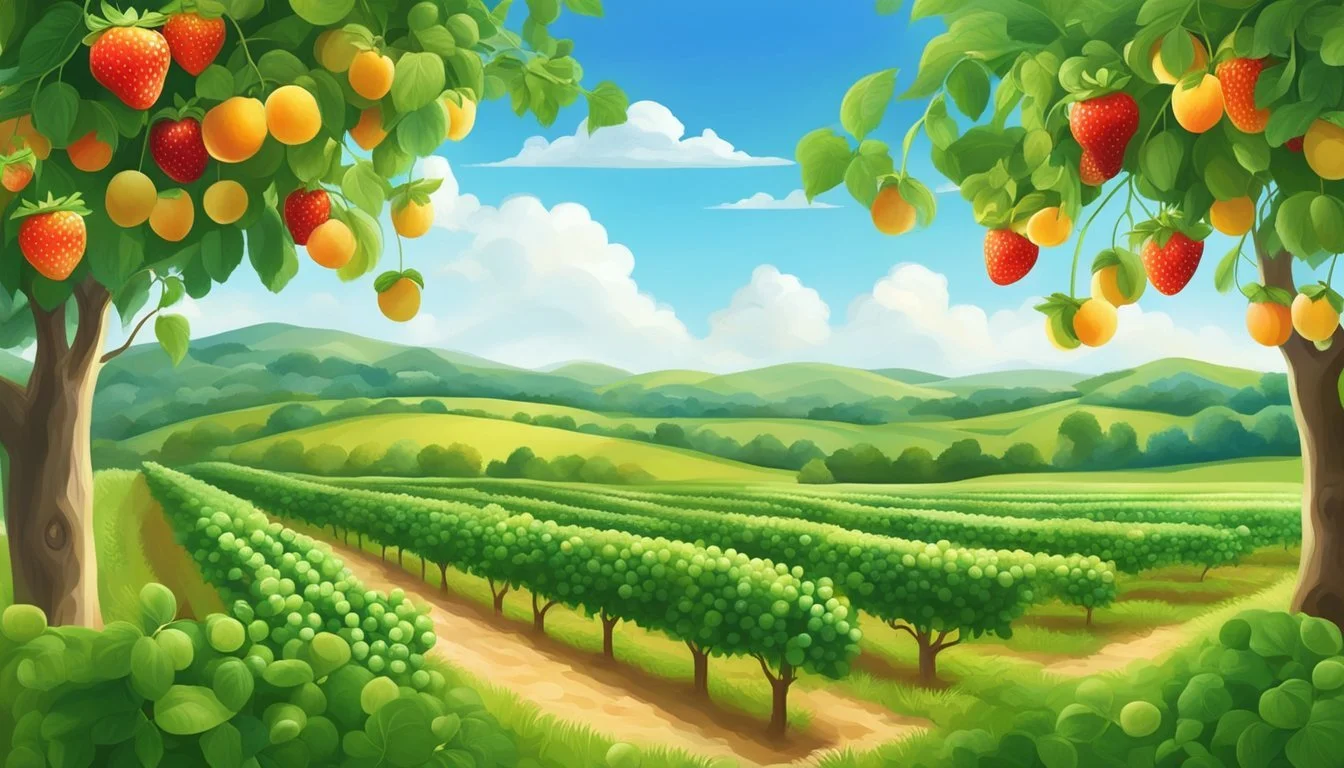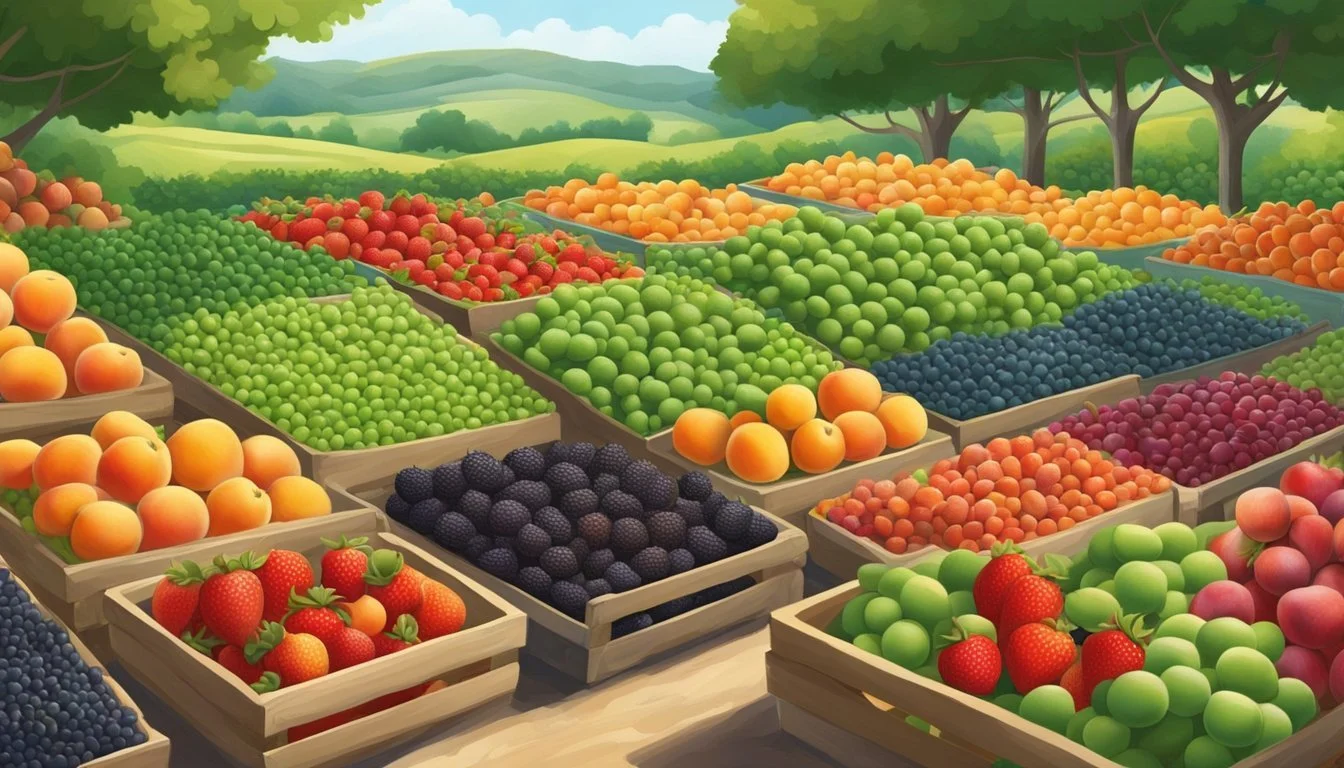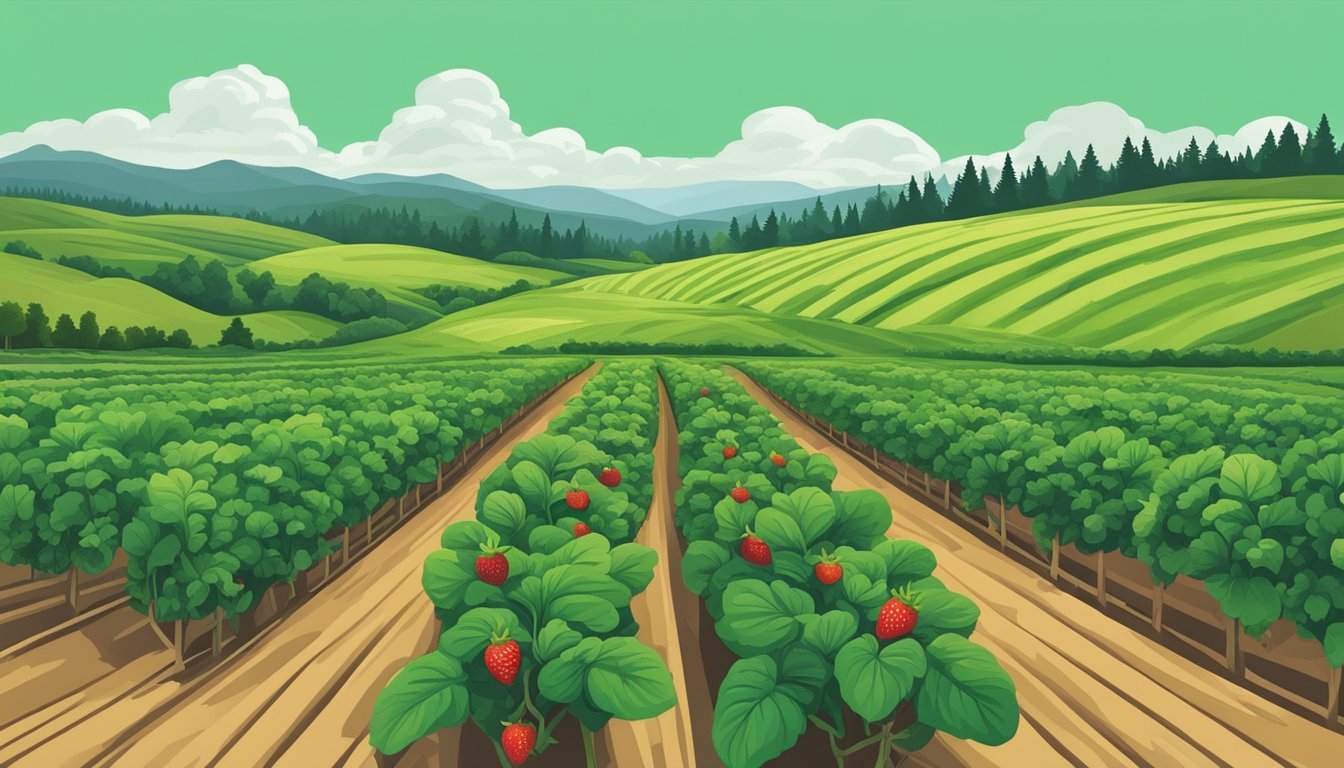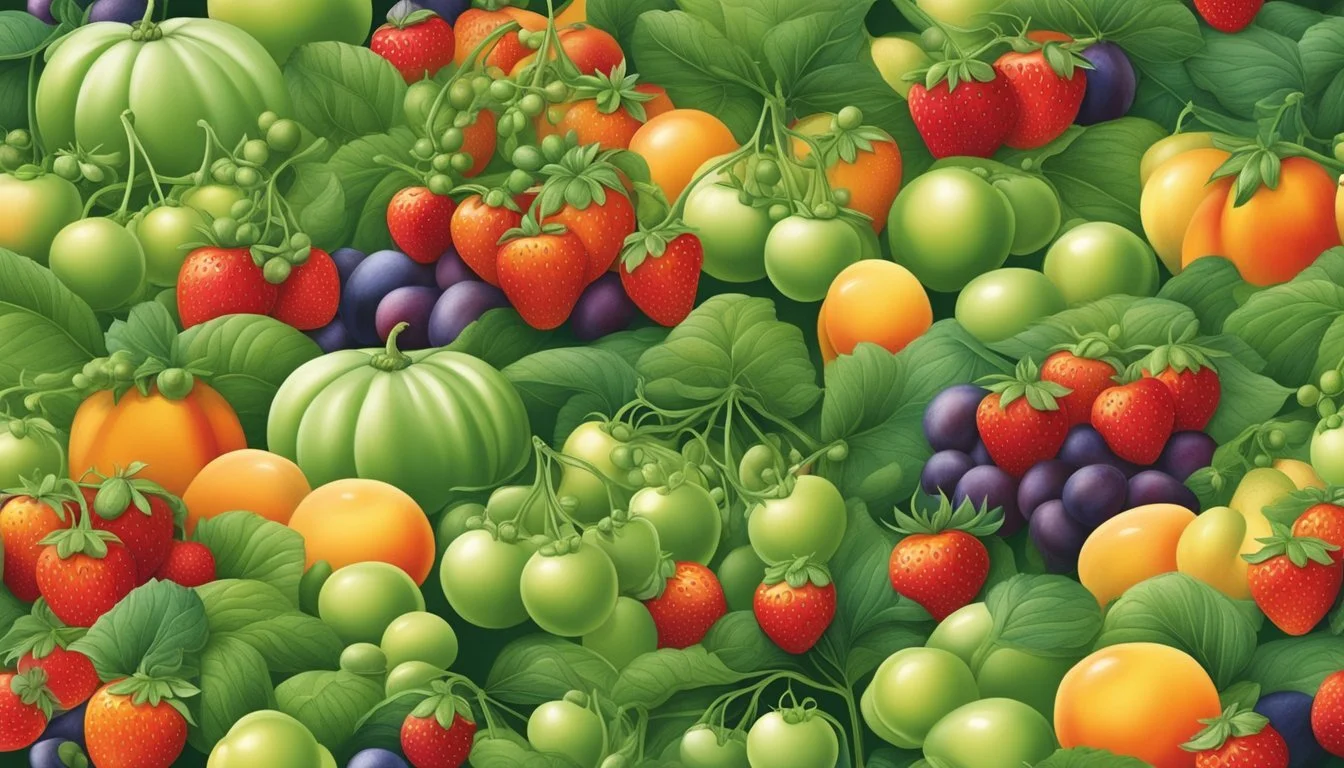Oregon Seasonal Fruit & Vegetables in June
Your Guide to Fresh Produce
This Article is Part of our Oregon Seasonal Fruit & Veg Calendar
June marks a vibrant period for Oregon's agricultural calendar, with an abundance of fresh fruits and vegetables reaching their peak. As the region transitions from the fresh blooms of spring to the warmer, verdant days of early summer, local farms and markets begin to showcase the rich variety of produce that Oregon's unique climate affords.
The month's bounty is diverse, offering a rich tapestry of flavors and textures. Berries become a focal point in Oregon during June, with blueberries (how long do blueberries last?), blackberries (how long do blackberries last?), and boysenberries ripe for picking, providing a fresh, tangy essence to the season's palate. Meanwhile, vegetables like beets, broccoli, and cabbage are harvested, delivering earthy and robust components to the array of June produce.
Consumers can take advantage of Oregon's fresh June harvest to enjoy produce at its nutritional and flavorful best. The state's dedication to sustainable farming practices means that the fruits and vegetables are not just a feast for the senses, but also nurtured with care for the environment, ensuring that the seasonal cycle of produce continues to thrive for years to come.
Key Considerations for Seasonal Produce
When choosing seasonal produce in Oregon, particularly in June, it is essential to consider the season's impact on the yield, quality, and availability of fruits and vegetables.
Understanding Seasonality
In Oregon, seasonality refers to the specific times of year when various fruits and vegetables are at their peak for harvest. June in Oregon signals the start of summer, a season when the weather favors the growth of a rich variety of produce. Consumers can enjoy the freshest and most flavorful items that are harvested at their ripest point.
Benefits of Eating Seasonally
Consumers who opt for seasonal produce enjoy numerous benefits. The flavor and nutritional value of fruits and vegetables are optimal in season. Furthermore, purchasing from local farms supports local farming operations and contributes to sustainability. Eating seasonally can also lead to a more diverse diet and a greater appreciation for foods available at different times of the year.
Challenges Faced by Oregon Farmers
Oregon farmers face weather-related challenges that can affect the output and quality of produce. Variability in rainfall and temperatures can impact the growing season. Farmers must strategically manage water resources and adapt to changing conditions to ensure that they can provide fresh, high-quality produce throughout the season.
Selecting High-Quality Produce
To select high-quality produce, consumers should look for fruits and vegetables that appear fresh and ripe with vibrant colors and firm textures. The produce should also have a fresh scent and be free of bruises and blemishes. Farmers’ markets and local produce stands are excellent sources for the freshest seasonal items.
Preservation and Storage Techniques
Proper preservation and storage are key to extending the life of seasonal produce. Techniques such as canning, freezing, and drying allow consumers to enjoy the taste of June's bounty even beyond its season. These methods also retain much of the produce's nutritional value and are perfect for capturing the flavor of fresh foods to be enjoyed later.
By considering these key points, consumers can take full advantage of Oregon's seasonal offerings, enjoying the benefits of fresh produce and supporting local agriculture.
Fruits in Season
In June, Oregon's agricultural tapestry weaves an abundance of fresh, ripe fruits perfect for enjoying raw or cooked into timeless desserts like cobblers and pies. The vibrancy and variety of berries, stone fruits, and core fruits offer an array of sweet and tart flavors.
Berries
Strawberries: These red, juicy gems start the summer with a burst of sweet flavor, ideal for eating fresh or incorporated into desserts.
Blueberries: (how long do blueberries last?) Enjoy these plump, mildly tart berries raw for a healthy snack, or bake them into a classic blueberry pie.
Blackberries: Recognizable for their deep purple hue, they are deliciously edible on their own and are a staple in fruit cobblers.
Stone Fruits
Cherries (how long do cherries last?): Sweet cherries peak this month, providing a delightful pop of flavor suited to both raw snacking and baking.
Apricots: With their soft, velvety skin, apricots come into season, lending a sweet-tart taste to any dish.
Nectarines and Peaches: These closely related fruits begin to sweeten in June, often used interchangeably in pies and other desserts.
Core Fruits
Apples: Certain early varieties of apples are harvested, offering a crisp, tangy addition to the season's selection.
Pears: While not at their peak, some early varieties may start to appear, with a promise of more to follow in the coming months.
Vegetables in Season
Oregon's bountiful June harvest offers a variety of fresh vegetables perfect for salads (What wine goes well with salads?) and summer dishes. From leafy greens to crisp root vegetables, this guide will help you explore what's ripe and ready in this vibrant season.
Leafy Greens
In June, Oregon is rich with a variety of leafy greens that are both nutritious and flavorful. Shoppers will find lettuce, spinach, kale, chard, and arugula in abundance. These greens are ideal for fresh, vibrant salads and provide an excellent source of vitamins and minerals.
Root Vegetables
Root vegetables like beets, carrots, radishes, and turnips are also in season during June. They add crunch and color to any dish and retain much of their nutrient content whether they are consumed raw or cooked.
Podded Vegetables
Podded vegetables are a sign of early summer, and Oregon does not disappoint with its selection. Garden peas, including snap peas, snow peas, and fava beans, (how long do fava beans last?) are harvested in June. These tender and sweet pods can be enjoyed fresh or can add a burst of flavor to cooked dishes.
Summer Squashes
June marks the arrival of summer squashes in Oregon. Varieties like zucchini and yellow summer squash are versatile ingredients that thrive in the warm weather. They can be grilled, sautéed, or even spiralized for a fresh take on pasta dishes.
Other Vegetables
A range of other vegetables, such as cucumbers (how long do cucumbers last?), green beans, peppers, broccoli, and cauliflower, are also ready for harvest. Tomatoes start to make an appearance, and cabbage, onions, and various types of squash fill the farmers' markets, providing endless options for cooking and enjoying fresh June produce.
Herbs and Garnishes
In June, Oregon's gardeners and local farms harvest a vibrant selection of herbs and garnishes that add freshness and flavor to any dish.
Basil thrives in June's warmer temperatures, contributing a sweet, yet peppery taste to recipes. It is a versatile herb often used in salads, as a garnish on pizzas and pastas, or to make fresh pesto.
Sage is another herb that grows well during Oregon's June season. With its earthy and slightly peppery flavor, sage is perfect for adding depth to meat dishes, infusing butters, or seasoning roasted vegetables.
Garlic Scapes, the curly stalks from garlic plants, are also harvested in this month. These scapes provide a milder, more delicate garlic flavor and can be used in place of garlic in many dishes. They are excellent when grilled, sautéed, or chopped into salads.
Lastly, Cilantro, known for its vibrant, citrusy taste, is in its prime. It's often spotted in salsas, as a topping for tacos, or as a fresh addition to rice dishes.
Herb Description Uses Basil Sweet and peppery Salads, garnishes, pesto Sage Earthy, peppery Meats, infused butters, roasted veggies Garlic Scapes Mild garlic flavor Grilled, sautéed, salads Cilantro Vibrant, citrusy Salsas, tacos, rice dishes
These herbs and garnishes, harvested at their peak in June, offer a bounty of options for culinary enthusiasts looking to enhance their dishes with fresh, local flavors of Oregon.
Planning and Preparing Seasonal Meals
In June, an abundant variety of fruits and vegetables reaches its peak in Oregon, offering a wide array of flavors and ingredients for meals. One can take advantage of the fresh produce for salads, incorporate them into cooking, preserve them for later use, and organize meal plans.
Salads and Raw Dishes
With the arrival of summer, salads become a refreshing meal choice. Using tomatoes, cucumbers, and greens, which are at their ripest, can ensure a burst of flavor and nutrition. Adding herbs like basil or mint enhances the freshness of these dishes. For a touch of sweetness, tossing berries into salads contributes both color and taste.
Tomatoes: Slice them for caprese salads (What wine goes well with caprese salad?) or chop for salsas.
Cucumbers: Peel and dice for a crisp addition to any salad.
Berries: Use as a topping for fresh greens or mix into fruit salads.
Cooking and Baking
Longer days and warmer temperatures bring opportunities for outdoor cooking, including grilling and picnics. Vegetables like squash, eggplant (What wine goes well with eggplant?), and sweet potatoes are versatile and can be grilled, roasted, or used in bakes. For desserts, nothing speaks "June in Oregon" like a homemade berry pie or cobbler.
Squash / Eggplant: Perfect for grilling or incorporating into stir-fries.
Berries: Ideal for pies, cobblers, and other baked goods.
Preserving the Harvest
Canning, pickling, and jam-making allow the flavors of summer to be enjoyed all year long. Berries can be transformed into jams or jellies, while cucumbers are perfect for pickling. Tomatoes can be canned whole, as sauces, or salsas.
Jam-making: Berries are high in pectin (how long does pectin last?), making them great for jams.
Pickling: Cucumbers can be easily pickled with vinegar, spices, and herbs.
Seasonal Meal Planning
Creating a meal prepping plan that incorporates June's bounty is both rewarding and efficient. Begin with crafting shopping lists that prioritize seasonal produce and seek out farmers markets for the freshest options. Design recipes that feature the flavors of the season, and consider preparing some ingredients in advance to save time.
Shopping Lists: Include fresh seasonal produce from local markets.
Meal Prepping: Plan for meals that incorporate a variety of seasonal vegetables and fruits.
By focusing on what's in season, meals become a reflection of the best flavors available and encourage support of local agriculture.
Sourcing Seasonal Produce
In June, Oregon bursts with a diverse range of fresh, local produce available through various sustainable channels. This section provides guidance on where to find seasonal fruits and vegetables, how to ensure you're supporting local farms, and tips to identify the ripest and most flavorful produce.
Farmers Markets and Roadside Stands
Farmers markets and roadside stands are quintessential for finding Oregon-grown seasonal produce directly from the source. Not only does purchasing from these local markets support the community, but it also offers a chance to engage with growers. Here, one can find a variety of fresh fruits such as strawberries and cherries, alongside vegetables like rhubarb that are picked at their peak.
Strawberries: June is peak strawberry season.
Cherries: Look for ripe, plump cherries at these local outlets.
To ensure sustainability and support for local farms, shoppers are encouraged to look for signs that denote organic practices or certifications at these stands.
Community Supported Agriculture (CSA)
Community Supported Agriculture, or CSA, represents a season-long commitment between consumers and their local farms. Consumers purchase a share of the harvest upfront, which allows farmers to plan accordingly and guarantees a supply of fresh, seasonal produce for the member. Among June's bounty, one can expect to receive:
Freshly picked blueberries
A range of leafy greens perfect for summer salads
CSAs often include options for organic produce, and participating ensures you are eating seasonally and locally, reducing the carbon footprint associated with long-distance food transport.
Grocery Shopping Tips
When shopping for produce at grocery stores in Oregon, it is important to:
Look for labels indicating local and seasonal produce.
Check for Oregon-based farm labels to ensure the produce is fresh and has traveled minimal distances.
June is an ideal month to find Oregon-grown:
Blueberries: They should be firm to the touch and have a uniform deep blue color.
Various greens: Look for vibrant color and crisp texture.
Shoppers who prioritize sustainability should choose produce that is both in season and grown locally to support the local community and reduce food miles. Keep an eye out for ripe, fresh selections to enjoy the best quality and flavor.
Conclusion
June in Oregon showcases an abundance of fresh produce, benefiting both local economy and consumer health. Strawberries and cherries stand out in the market, being at their peak for flavor and nutrition. It is an ideal time for individuals to include these fruits in their diets, supporting the premise of eating seasonally for enhanced taste and nutritional value.
In terms of vegetables, June offers a variety of options such as peas, beets, and leafy greens, which are fresh on the shelves. They cultivate these vegetables employing sustainable practices that align with Oregon's commitment to environmental stewardship. This adherence not only maintains soil health but also reduces the carbon footprint associated with long-distance transportation of produce.
Oregon Seasonal Produce in June Fruits Strawberries Cherries Rhubarb Vegetables Leafy Greens Peas Beets
Farmers markets and local food systems are at the heart of Oregon's seasonal movement. Consumers have the unique opportunity to connect directly with growers, understand cultivation methods, and select from a bounty of just-harvested produce.
In summary, the month of June is a vibrant time for Oregon's agricultural landscape. Eating seasonally during this month facilitates a sustainable lifestyle, supports local farmers, and ensures that Oregonians receive the highest quality of produce available.






